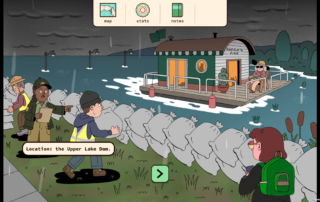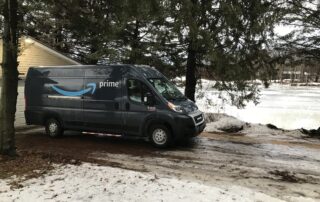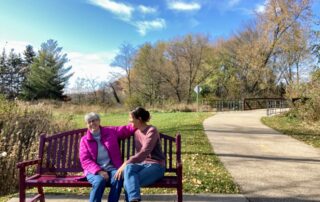Trekking into Wisconsin’s great Northwoods you never know what you might encounter. A deer, a bear or perhaps Department of Natural Resources Biologist Laine Stowell covered in camouflage from head to toe. His walk through the woods is cautious, calculated and cunning as he plunges deep into the wild along paths rarely traveled. Using telemetry and radio collars Stowell is tracking an elusive forest creature. He whispers, “They’re out in that direction. Once we can get up to where we can see, I’ll start calling to see if we can draw him to us. But he’s not very far away.”
Stowell is trying to lure into the open an elusive bull elk. Using an elk horn Stowell mimics the sound of a female elk. Again and again the horn echoes through the Chequamegon-Nicolet National Forest. It’s mating season and this call of the wild is signal of another season passing. On this morning, the bull elk that Stowell is pursuing is a no show. It’s in the area but just not that interested in making an appearance, but that doesn’t stop Stowell from trying.
Stowell said, “It’s a labor of love, otherwise I wouldn’t be doing it.” The mission of restoring elk to the Wisconsin wilderness has become personal and at the same time he certainly sees it as a challenge to keep perspective. Stowell said, “You do lose some of those animals, and that’s why we don’t give them names. We give them numbers. I feel like I know them pretty good.”
Stowell returns to his truck, as he’s done for more than 16 years and turns to the big antenna protruding from roof of the cab to track Wisconsin’s wild elk. He admits that he has an advantage with radio telemetry because a good number of the elk have radio collars. But even with that advantage Stowell admits it is only about a quarter of the time that he actually sees an elk. The antenna and tracking device help him get within close proximity.
Elk have a long history in Wisconsin. They roamed free across the wilderness here until loggers and hunters forced them out before the turn of the 19th Century. Stowell sees it as his mission to bring back an animal that was once abundant here. Stowell said, “It’ll be successful if we have a viable population and my grandchildren or my grandchildren’s grandchildren are able to come and see and hear evidence of elk in Wisconsin.”
Wisconsin’s elk reintroduction got a boost in 1995 when Michigan donated 25 elk. From those 25, the herd has now grown to around 170 elk. Starting in 2016 and over the next two years, the DNR would bring in another 75 elk from Kentucky. The new introduction would help diversify the genetics in Wisconsin’s elk herd. The Ho-Chunk Nation contributed more than $200,000 towards that restoration. In the ceded territories, the Great Lakes Indian Fish and Wildlife Commission is the DNR. They are the natural resources department for the Ojibwa Nation and are involved in management efforts of elk. The Ojibwa also contribute financially to the management through the gaming monies.
Wisconsin’s growing elk herd will need room to roam. At the same time, the elk are seen as a tourist magnet. Giving the elk plenty of room and also managing tourists in areas like Winter, Clam Lake and Butternut, Wisconsin will be a balancing act for the DNR. Stowell admits, “It’s a challenge. For people coming into that area to view elk. Millions of dollars are generated by that.” If they are lucky enough visitors can hear the bulls bugle, see their tracks or antler rubs where a tree was bent over by fully horned bull elk. The goal for the Clam Lake Elk Range, which is 1620 square miles in size is 1400 elk.
Predators and harsh winters have taken their toll on Wisconsin’s emerging elk herd. Since 1995 the DNR has documented 262 mortalities. Of those 42% are the result of wolf attacks, and 11% are due to bear predation on young calves. The third cause of mortalities is vehicle collisions. Stowell said, “The DNR installed a warning system along six miles of Highway 77 where there were above average elk-vehicle collisions.” The lights will blink if elk are coming towards the highway.
As a result of Stowell’s work, elk are at home once again in Wisconsin’s Northwoods. During the past 16 years as an elk biologist Stowell has helped radio collar 300 adult elk and a couple hundred calves. At the same time he’s learned a great deal from this herd. Stowell said, “I think it’s my philosophy that the bringing back of a species that disappeared is righting a wrong. And that’s probably one of the highest callings of a wildlife biologist.”
The Return of Elk
Elk were once native to Wisconsin, but have long been gone. In 1995, elk were reintroduced to the state through the efforts of private citizens including members of the Rocky Mountain Elk Foundation. The organization raised enough money to bring 25 elk from Michigan to the Chequamegon National Forest near Clam Lake. In 2000, the Wisconsin Department of Natural Resources took over management of the herd, which has grown to about 120 animals. In 2004, Wisconsin Public Television looked into how the DNR monitors the health of the herd and explores other aspects of the future of elk in the state.
Elk Follow-up
While the elk herd has increased at a healthy rate, humans are once again threatening the existence of the animals. However, the threat does not come from hunters… but rather from people who believe they’re helping the elk. DNR officials say that elk fatalities are up 350% from mid-May 2004 to mid-May 2005. Officials believe that this is due in part to people providing food in their backyards for elk. The danger in feeding elk comes when the animals cross busy roads or thinly-iced rivers and lakes to get to the food. There is an additional danger of disease when wild animals converge in the same eating areas. Wisconsin Public Television reported on the DNR’s effort to alert and educate residents in the Clam Lake area about the negative impact backyard feeding has on the elk population.










